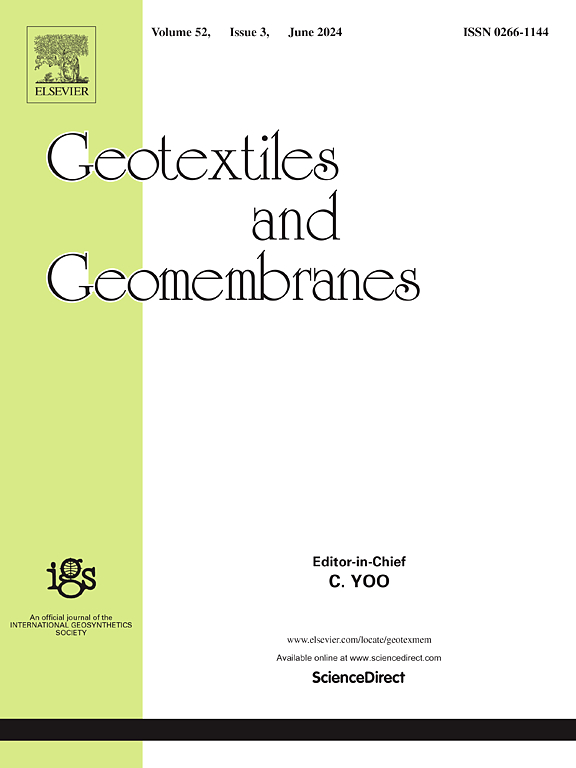土工膜变形方法对土工膜-干GCL界面剪切性能的影响
IF 6.2
1区 工程技术
Q1 ENGINEERING, GEOLOGICAL
引用次数: 0
摘要
采用四种不同类型的土工膜进行了大规模直剪试验,分别是撞击式土工膜(GMTI)、共挤式土工膜(GMTC)、低粗糙度压纹土工膜(GMTEL)和高粗糙度压纹土工膜(GMTEH),研究了土工膜变形方法对土工膜(GM)与干土工合成粘土衬垫(GCL)非织造侧界面剪切行为的影响。GCL含有颗粒状膨润土,介于编织和非织造土工布之间,通过针刺粘合。在干GCL上进行了试验,以将GM-GCL界面行为与其他因素隔离开来。所有界面均表现出相似的应变软化剪切行为。纹理类型对GM-GCL界面行为有较大影响。利用GMTI和GMTC获得了变形颗粒与土工布纤维直接表面接触的剪切位移曲线。与GMTC相比,GMTI在剪切过程中纹理分层,减少了土工布的精梳。GMTEL通过尖端渗透和表面摩擦与GCL上的土工布接触,如GCL表面的条纹所示,导致有纹理的gm的界面强度最低。GMTEH深入GCL内部,导致土工布膨胀、撕裂,膨润土出现沟壑,界面强度是所有测试中最高的。本文章由计算机程序翻译,如有差异,请以英文原文为准。
Effect of geomembrane texturing method on geomembrane-dry GCL interface shear behavior
Effect of geomembrane texturing method on interface shear behavior between textured geomembranes (GM) and the nonwoven side of a dry geosynthetic clay liner (GCL) was evaluated using large-scale direct shear tests conducted using geomembranes with four different types of texturing and a range of asperity heights: impinged texturing (GMTI), coextruded texturing (GMTC), low asperity embossed texturing (GMTEL), and high asperity embossed texturing (GMTEH). The GCL contained granular bentonite between woven and nonwoven geotextiles bonded by needlepunching. Tests were conducted on the dry GCL to isolate GM-GCL interface behavior from other factors. All interfaces exhibited similar strain-softening shear behavior. Type of texturing had a strong influence on GM-GCL interface behavior. Comparable shear-displacement curves involving direct surface engagement between the texturing asperities and geotextile fibers were obtained with GMTI and GMTC. GMTI texturing delaminated during shear, reducing geotextile combing compared to GMTC. The GMTEL engaged the geotextile on the GCL via tip penetration and surface friction, as evinced by striations on the GCL surface, resulting in the lowest interface strengths of the textured GMs. GMTEH engaged deep into the interior of the GCL, resulting in dilation, tearing of the geotextile, furrows in the bentonite, and the highest interface strength of those tested.
求助全文
通过发布文献求助,成功后即可免费获取论文全文。
去求助
来源期刊

Geotextiles and Geomembranes
地学-地球科学综合
CiteScore
9.50
自引率
21.20%
发文量
111
审稿时长
59 days
期刊介绍:
The range of products and their applications has expanded rapidly over the last decade with geotextiles and geomembranes being specified world wide. This rapid growth is paralleled by a virtual explosion of technology. Current reference books and even manufacturers' sponsored publications tend to date very quickly and the need for a vehicle to bring together and discuss the growing body of technology now available has become evident.
Geotextiles and Geomembranes fills this need and provides a forum for the dissemination of information amongst research workers, designers, users and manufacturers. By providing a growing fund of information the journal increases general awareness, prompts further research and assists in the establishment of international codes and regulations.
 求助内容:
求助内容: 应助结果提醒方式:
应助结果提醒方式:


